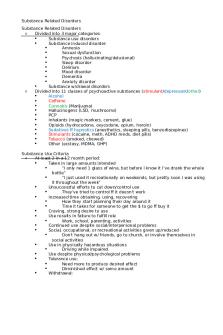Substance Abuse.Concept Map PDF

| Title | Substance Abuse.Concept Map |
|---|---|
| Course | Professional Nursing |
| Institution | California State University Northridge |
| Pages | 1 |
| File Size | 194.3 KB |
| File Type | |
| Total Downloads | 9 |
| Total Views | 137 |
Summary
Concept Map...
Description
ETIOLOGY / RISK FACTORS
ABUSED SUBSTANCE DESCRIPTION Central Nervous System depressants are drugs that slow down brain activity. They operate by affecting the neurotransmitter, which leads to the side effects of drowsiness, relaxation and increased inhibition. CNS depressants treat insomnia, anxiety, stress, panic attacks, pain and seizures. Sedatives, Hypnotics and Tranquilizers are among the different types of major CNS depressants.
-Taking more than prescribed amount -Mixing medication with alcohol -Non-prescription use -Street drugs -Addictive drugs
SIGNS & SYMPTOMS OF WITHDRAWAL
SIGNS & SYMPTOMS OF ABUSE SUBSTANCE ABUSED
-Ataxic gait (abnormal/ uncoordinated movements) -Decreased respirations -Memory loss
-Slurred speech
DEPRESSANTS
-Reduced hunger or thirst
-Nausea and vomiting
-Insomnia
-Hallucinations
-Restlessness
-Seizures
-Shaking
-Panic Attacks
-Irritability
-Anxiety
-Pinpoint (small) pupils
-Respiratory depression -Sense of having heaviness in extremities
DIAGNOSIS (DIAGNOSTIC TESTS / LABS) -Diagnosing a person with substance abuse requires thorough evaluations done by psychiatrists, psychologists and drug counselors. A 10-panel drug test detects barbiturates, benzodiazepines, methaqualone, methadone and propoxyphene. Comprehensive tests are done on patients that suffer from both a mental and substance abuse disorder because they exhibit severe symptoms and may be resistant to treatment. They must be monitored in order to differentiate withdrawal symptoms and substance intoxication.
TREATMENT -Medically supervised detoxification
MEDICATIONS
PATIENT PROBLEM / PATIENT PROBLEM NURSING INTERVENTIONS NURSING INTERVENTION
-Naltrexone (opioid abuse)
-Ineffective individual coping
-Imbalanced Nutrition
-Methadone
-Nursing Interventions:
-Nursing Interventions:
-Buprenorphine
-Encourage verbalization of feelings and fears
-Review lab studies (glucose, serum albumin and prealbumin) to identify any anemias or electrolyte imbalances
-Drug craving management -Recovery and life skills education
-Lofexidine
-Outpatient programs, support groups, meetings and classes
-Opioid agonists relieve withdrawal symptoms and cravings
-Cognitive Behavioral Therapy -Help patient avoid relapse
-Set up diversion activities relating to recovery; self-help groups help patient learn and promote abstinent mentality -Determine patient’s understanding of current situation (degree of acceptance/ denial)
-Consult with a dietician -Provide patient with opportunity to choose their own foods -Provide positive reinforcement, acknowledge their efforts...
Similar Free PDFs

Substance Abuse.Concept Map
- 1 Pages

Substance Related Disorders
- 9 Pages

1.2. Amount of Substance
- 4 Pages

Chapter 17 Substance Abuse
- 1 Pages

CH 6 Substance USE Assessment
- 6 Pages

campus map campus map campus map
- 1 Pages

real gas and pure substance
- 3 Pages

Wetting Property OF A Substance
- 7 Pages

Campus map - map
- 1 Pages

Doctrine of Pith and Substance
- 4 Pages

Visitor Map - map or campus
- 1 Pages

Mind Map - Quiz- mind map
- 1 Pages

Hemophilia Mind Map - Mind Map
- 1 Pages

D024 Mind Map - Mind map.
- 1 Pages

Human Cultural Map - Map outline
- 2 Pages
Popular Institutions
- Tinajero National High School - Annex
- Politeknik Caltex Riau
- Yokohama City University
- SGT University
- University of Al-Qadisiyah
- Divine Word College of Vigan
- Techniek College Rotterdam
- Universidade de Santiago
- Universiti Teknologi MARA Cawangan Johor Kampus Pasir Gudang
- Poltekkes Kemenkes Yogyakarta
- Baguio City National High School
- Colegio san marcos
- preparatoria uno
- Centro de Bachillerato Tecnológico Industrial y de Servicios No. 107
- Dalian Maritime University
- Quang Trung Secondary School
- Colegio Tecnológico en Informática
- Corporación Regional de Educación Superior
- Grupo CEDVA
- Dar Al Uloom University
- Centro de Estudios Preuniversitarios de la Universidad Nacional de Ingeniería
- 上智大学
- Aakash International School, Nuna Majara
- San Felipe Neri Catholic School
- Kang Chiao International School - New Taipei City
- Misamis Occidental National High School
- Institución Educativa Escuela Normal Juan Ladrilleros
- Kolehiyo ng Pantukan
- Batanes State College
- Instituto Continental
- Sekolah Menengah Kejuruan Kesehatan Kaltara (Tarakan)
- Colegio de La Inmaculada Concepcion - Cebu
